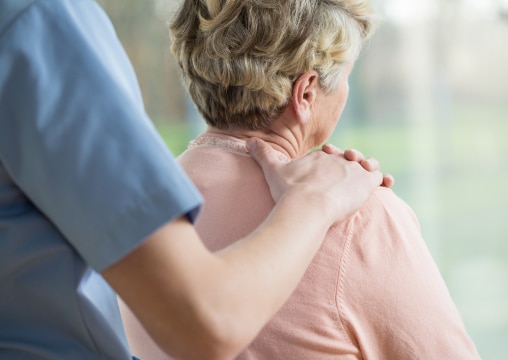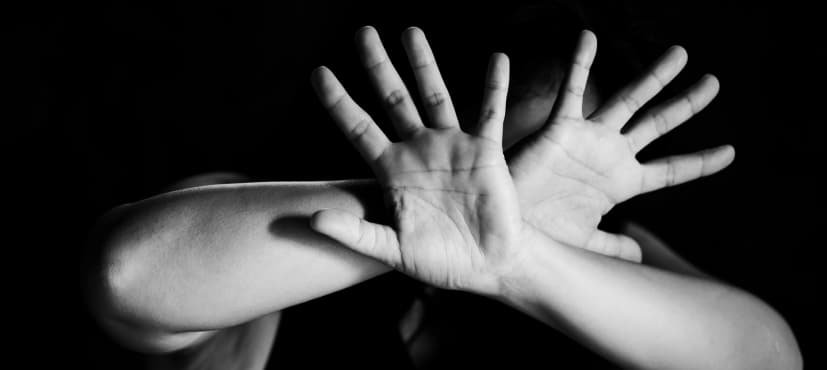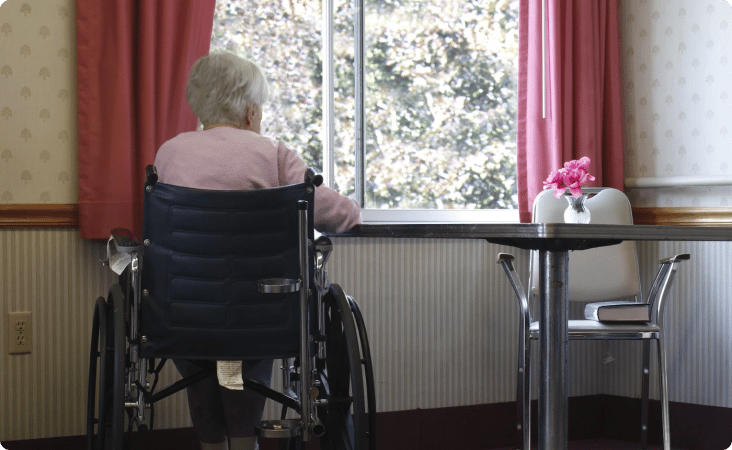Sexual Abuse in Nursing Homes

Home ▸ Nursing Home Abuse ▸ Sexual Abuse
- What is sexual abuse?
- Sexual Abuse Is the Least Reported Type of Elder Abuse in Nursing Homes
- Signs of Sexual Abuse in Nursing Homes
- Who is most at risk for sexual abuse in nursing homes?
- Who are the perpetrators of sexual abuse in nursing homes?
- What to Do if Your Loved One Is a Victim of Sexual Abuse in a Nursing Home
- Statute of Limitations for Nursing Home Abuse
- Call a Nursing Home Abuse Lawyer
Moving an older loved one into a nursing home is not a decision families take lightly. Everyone wants to make sure their beloved elders are comfortable and receive the best care possible. They want to be assured they will be treated with dignity and that they will be surrounded by people they can trust.
When any type of abuse happens in a nursing home, it is shocking.
Elder abuse happens when someone acts intentionally or fails to act in a way that creates a risk to an older adult. In a nursing home facility, the abuse often occurs at the hands of a trusted caregiver. Elder abuse can include any of the following:
- Physical abuse
- Emotional or psychological abuse
- Financial abuse
- Sexual abuse
- Neglect
The idea of an older adult being subjected to willful abuse or neglect is abhorrent. However, studies show that about 10 percent of people over the age of 65 experience some kind of abuse. In the US, a study of sexual abuse prevalence shows that 0.6 percent of older people are victims of unwanted attention.
What is sexual abuse?
A short definition of sexual abuse is any kind of sexual contact that is not consensual. Physical contact that constitutes sexual abuse can include:
- Unwanted touching
- Rape
- Sodomy
- Coerced nudity
- Sexually explicit photography
Sexual abuse can also include sexual harassment. This includes any kind of unwelcome sexual comments made to an individual or even to a group of people.

Sexual Abuse Is the Least Reported Type of Elder Abuse in Nursing Homes
Nursing homes are not free from sexual abuse. As much as 7 percent of all nursing home abuse is sexual in nature. Researchers say that the small percentage of reported sexual abuse may be the result of misreported physical abuse. This misreporting makes it difficult to understand just how prevalent the problem is.
Of the abuse that is reported, sexualized kissing and fondling are most often noted, along with inappropriate sexual interest in the victim’s body. Research also reveals that a single case often includes multiple types of abuse.
Shockingly, it is estimated that only between 1 in 14 to 1 in 24 cases of elder abuse are ever reported. As our aging population continues to grow, the number of unreported abuse cases could be staggering.
Signs of Sexual Abuse in Nursing Homes
If you have a beloved older family member in a nursing home, it’s important to pay attention to potential warning signs of sexual abuse. Depending on the older adult’s cognitive condition, emotional state, and social awareness, it can be difficult to determine abuse. Signs of sexual abuse in an older adult include:

Bruises, lacerations, or abrasions around the genital area or breasts

Increased depression

Unexplained vaginal bleeding

Agitation

Unexplained anal bleeding or incontinence

Sleep disturbances or restlessness

Increased anxiety
Older adults experience the impact of sexual abuse differently depending on the individual. Effects of poor treatment of any sort are related to the scope, type, and degree of the abuse. The impact of the abuse is also influenced by multiple other factors, including mental health and socio-cultural status.
A prior history of sexual trauma could understandably result in increased effects of new sexual abuse. During sexual abuse, the older person can sustain physical injuries and psychological harm. Because of the mental anguish associated with sexual abuse, family relationships may deteriorate, which could result in a diminished quality of life.
Impacts that could be associated with sexual abuse include:
- Post-traumatic stress syndrome (PTSD)
- Sleep disturbances
- Changes in self-image
- Depression
- Anxiety
- Dissociative symptoms
- Increased hospitalizations
- Overall poor health
- Feelings of shame and guilt
Take note of any changes in mood or behavior when you visit your relative in a nursing home. Often, they are not able to look after themselves and may need you to be their voice.
Who is most at risk for sexual abuse in nursing homes?
Elder mistreatment in nursing homes is likely equal to or more prevalent than abuse that occurs in domestic settings. Understanding which nursing home residents are most at risk for sexual abuse can help determine ways to curb this phenomenon.
Identifying potential victims is complicated and includes qualities having to do with the victim and also the perpetrator.
Commonly observed examples of victim risk factors include:
- Functional disability and dependence
- Mental health problems
- Cognitive defects
- Prior trauma
- Limited social support
- Poor relationship with the perpetrator
These risk factors are common among older adults who are abused sexually. Some other factors are also worth discussing in terms of who is more likely to suffer sexual abuse in a nursing home.

Women
According to adult protective services and other agencies, the majority of elder abuse victims are female.
One survey suggests this is true because women make up a greater majority of the senior population. It has also been noted that women tend to endure more serious abuse and sustain greater physical and emotional trauma from their mistreatment.

Dementia
Studies suggest that dementia or Alzheimer’s disease create risk factors for the sexual abuse of an elderly person. Individuals afflicted with these diseases can be seen as easy targets because of their diminished mental and memory capacities.

Social Isolation
Older people who are often alone or who have a poor social network are at increased risk for abuse. Visits from family and friends can help reduce the likelihood of abuse among nursing home residents.
If caregivers or other nursing home residents who are potential perpetrators see family and friends show interest, that social connection can deter them.

Men
One study found that out of 26 cases of reported sexual abuse of older males, six were confirmed upon inspection. This indicates that, although women appear to have the greater risk, older men are still at risk of sexual abuse.
The most common form of male sexual abuse substantiated through investigation was fondling. The victims tended to be white males who struggled with self-care for various reasons.
Who are the perpetrators of sexual abuse in nursing homes?
Nursing homes and other long-term care facilities have the highest rates of elder abuse. Research shows that the majority of perpetrators were men aged 18 and older. However, some women committed sexual abuse. Both staff and other nursing home residents were the most commonly reported abusers.
There were many cases in which the abuser had one or more of the following traits:
- Cognitive impairment
- Psychiatric diagnosis
- High levels of stress
- Alcohol abuse
- Drug abuse
- Criminal history
- Lack of social support
A person who commits sexual abuse on an older person can be driven by different motives. Two factors that all offenders had in common were that they looked for victims who were fragile and defenseless, and they scored low on social competence. In addition to these are some other interesting factors.
Negative Attitudes Toward Older People
Some studies suggest that caring for older adults is viewed negatively by modern society. If someone already has a negative attitude toward older people and finds themselves in a caregiving role, they can believe that the abuse is somehow deserved. This lack of empathy places the older adult in a more vulnerable state.
Victimization
Adults who were victims of or witnesses to family violence or sexual abuse can often become perpetrators themselves. There is debate about revenge being the motivation for abuse. It’s believed that the physical or sexual abuse suffered by the perpetrator results in problems with psychosocial adjustment later in life.
Relational Problems
A noticeable percentage of elder abuse perpetrators have problems with healthy relationships. Risk factors for abusers include conflict with others, social dysfunction, and social isolation. When an abuser feels no one knows or cares about their behavior, it is more likely to continue.
What to Do if Your Loved One Is a Victim of Sexual Abuse in a Nursing Home
Nursing home residents have the right to be treated with dignity and to be free from any sort of abuse. When nursing homes receive notification of various types of abuse allegations, they must:
- Act immediately to prevent further abuse
- Report the abuse to law enforcement and other state officials
- Conduct a thorough investigation
- Document and report the results of the investigation completely
If you suspect that your loved one has been the victim of sexual abuse, you should take the following steps without delay:
- Ensure your loved one’s safety
- Report the abuse to the facility administrator
- Call the police
- Seek a medical examination
- Call your state’s nursing home licensing and certification agency
- Call Adult Protective Services (APS)
- Call your local long-term care ombudsman
- Follow up with any needed mental health care
Also, reach out to an attorney to explore filing a lawsuit.
Talk Ahead of Time
Talking about abuse is the best way to prevent it from happening. Talk to your older loved one about the risks that may be present in a nursing home setting.
Encourage them to resist the temptation to feel any shame or embarrassment if sexual abuse takes place. Tell them they should immediately report any abuse and call the police. They also should preserve any evidence they can. This might include:
- Not bathing
- Not urinating
- Not washing or changing their bedding
- Not brushing their teeth or using a mouthwash product
If indicated, they may need to consent to a rape kit test to verify the abuse and identify the perpetrator.
An attorney who handles nursing home abuse can help you pursue a claim against the perpetrator and any other responsible parties. Attempting to establish legal liability without legal assistance can be difficult. Trying to determine appropriate damages is also harder if you have no similar experience.

Statute of Limitations for Nursing Home Abuse
Statutes of limitations set a deadline before which a person must file a claim regarding someone else’s wrongful act. You do not have unlimited time to pursue legal action.
The statute of limitations for nursing home abuse cases varies by state and ranges from one to six years. If you do not initiate legal action within the appropriate time, you will likely lose your right to pursue justice.
Call a Nursing Home
Abuse Lawyer
If you suspect your loved one has been the victim of nursing home sexual abuse, call a local experienced elder abuse attorney. Many personal injury attorneys will provide you with a free, no-obligation consultation. This allows you to share the details of your complaint to get their guidance.
Many nursing home abuse lawyers also work on a contingency fee basis. This means you won’t have to pay anything unless you recover damages on behalf of your loved one.
- Last Modified June 1, 2023
- Editorial Guidelines
Dr. Patricia Shelton, MD

Education:
- University of Washington, Doctor of Medicine – MD. June 2008
- University of Washington, Bachelor of Science – BS, Jun 2003
Background:
Neuroscience and Medicine
Career:
- Dr. Shelton primarily writes content for health-related websites, but has also written test prep materials, white papers, published research articles, court documents, and more.
- Dr. Shelton teaches anatomy and physiology at the college level for the National Institutes of Health.
